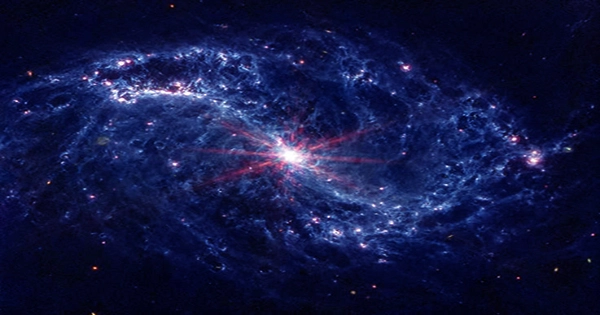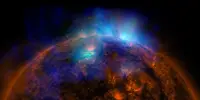More than 100 times brighter than they ought to be, these things are. NASA’s NuSTAR X-ray telescope observations provide credence to one potential answer to this conundrum.
The energy produced by ULXs, which often produce 10 million times more energy than the Sun, exceeds the Eddington limit by 100 to 500 times. Scientists are baffled as to how these cosmic objects can be so brilliant in light of this. A ULX was first measured by research recently published in The Astrophysical Journal using NASA’s Nuclear Spectroscopic Telescope Array (NuSTAR). The results show that ULXs do certainly exceed the Eddington limit, possibly because of their powerful magnetic fields.
About 10 million times as much energy as the Sun is produced by unusual cosmic objects called ultra-luminous X-ray sources. In fact, they appear to transcend the Eddington limit, a physical restriction on how light an item can be depending on its mass. This is because they are so brilliant. Scientists are baffled by the fact that ultra-luminous X-ray sources (ULXs) often surpass this limit by 100 to 500 times.

Researchers describe a first-of-its-kind measurement of a ULX obtained using NASA’s Nuclear Spectroscopic Telescope Array (NuSTAR) in a recent paper published in The Astrophysical Journal. The discovery indicates that these light emitters are as brilliant as they appear and that they exceed the Eddington limit. According to one theory, the ULX’s powerful magnetic fields are responsible for its record-breaking brilliance. However, scientists can only test this theory through observation: ULX magnetic fields, which are billions of times more powerful than the strongest magnets ever created on Earth, cannot be replicated in a lab.
Scientists used to believe that ULXs were black holes ringed by brilliant gas reservoirs. However, NuSTAR data revealed in 2014 that M82 X-2, a ULX, is actually a less massive object known as a neutron star. Neutron stars, like black holes, arise when a star dies and collapses, cramming more than the mass of our Sun into a region little larger than a mid-sized city.
This incredible density produces a gravitational pull on the neutron star’s surface that is 100 trillion times stronger than the gravitational pull on Earth’s surface. When gas and other material are dragged in by gravity, they accelerate to millions of miles per hour, releasing enormous energy when they hit the neutron star’s surface. (A marshmallow would have the energy of a thousand hydrogen bombs when placed on the surface of a neutron star.) The high-energy X-ray photons that NuSTAR can detect results from this.
The most current research focused on the same ULX at the center of the 2014 finding and discovered that M82 X-2 is robbing a nearby star of almost 9 billion trillion tons of material annually, or roughly 1 1/2 times the mass of the Earth. Scientists can predict how bright the ULX should be based on the quantity of material that interacts with the neutron star’s surface, and their calculations agree with other, independent observations of its brightness. The research proved that M82 X-2 is larger than the Eddington limit.
The so-called photons that make up light particles push everything they come into contact with somewhat. If a cosmic object, like as a ULX, emits enough light per square foot, the gravitational attraction of the item can be overcome by the outward push of photons. When this occurs, an object has reached the Eddington limit, at which point any gas or other material falling toward it should be pushed away by the object’s light.
That transition, when light triumphs over gravity, is important because the brightness of a ULX is caused by material falling onto it. This is a characteristic of black holes that scientists commonly observe: when their powerful gravity draws in stray gas and dust, those things may heat up and emit light.
Scientists used to believe that ULXs were black holes ringed by brilliant gas reservoirs. However, NuSTAR data revealed in 2014 that M82 X-2, a ULX, is actually a less massive object known as a neutron star. Neutron stars, like black holes, arise when a star dies and collapses, cramming more than the mass of our Sun into a region little larger than a mid-sized city.
This incredible density produces a gravitational pull on the neutron star’s surface that is 100 trillion times stronger than the gravitational pull on Earth’s surface. When gas and other material are dragged in by gravity, they accelerate to millions of miles per hour, releasing enormous energy when they hit the neutron star’s surface. (A marshmallow would have the energy of a thousand hydrogen bombs when placed on the surface of a neutron star.) The high-energy X-ray photons that NuSTAR can detect result from this.
The most current research focused on the same ULX at the center of the 2014 finding and discovered that M82 X-2 is robbing a nearby star of almost 9 billion trillion tons of material annually, or roughly 1 1/2 times the mass of the Earth. Scientists can predict how bright the ULX should be based on the quantity of material that interacts with the neutron star’s surface, and their calculations agree with other, independent observations of its brightness. The research proved that M82 X-2 is larger than the Eddington limit.
















